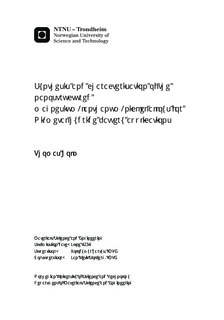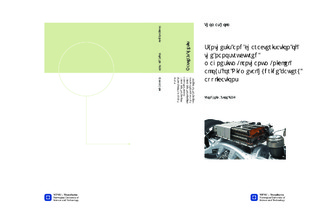| dc.contributor.advisor | Yartys, Volodymyr | nb_NO |
| dc.contributor.advisor | Solberg, Jan Ketil | nb_NO |
| dc.contributor.author | Holm, Thomas | nb_NO |
| dc.date.accessioned | 2014-12-19T13:26:20Z | |
| dc.date.available | 2014-12-19T13:26:20Z | |
| dc.date.created | 2012-11-08 | nb_NO |
| dc.date.issued | 2012 | nb_NO |
| dc.identifier | 565958 | nb_NO |
| dc.identifier | ntnudaim:7442 | nb_NO |
| dc.identifier.uri | http://hdl.handle.net/11250/249054 | |
| dc.description.abstract | Affordable price, high abundance of magnesium and high densities of hydrogenin the Mg-based hydrides attract interest to these hydrides tailored for hydrogenand energy storage applications. Ternary La-Mg-Ni hydrogen storage alloys withcomposition La3-xMgxNi9 (x = 0.8-1.2) form a new class of the materials for thenegative electrodes in Ni-Metal Hydride (MH) batteries. The electrochemical dischargecapacity of such alloys reaches 400 mAh/g which is 25 % greater than thatof the commercial AB5-type based electrodes, 315 mAh/g. The La3-xMgxNi9alloys crystallize with trigonal PuNi3 type of crystal structure. Magnesium replaceslanthanum to form the hybrid LaNi5 + Laves phase structures and favorablychanges the thermodynamics of the metal-hydrogen interactions allowingimproved performance of the advanced metal hydride battery electrodes.Differences in melting temperatures of lanthanum, nickel and easily evaporatingmagnesium and a complexity of the phase equilibria in the La-Mg-Ni systemcause difficulties in synthesis of the battery electrode alloys with controlled Mgcontent and a desired phase-structural composition.In present work a La2MgNi9 alloy was in focus. Its successful synthesis hasbeen achieved from the alloy melts containing 0-30 % of overstoichiometric Mgas compared to La2MgNi9 by use of Rapid Solidification performed at variousquenching rates, with a copper wheel rotation speed of 3.1, 10.5 and 20.9 m/s.They were analyzed by synchrotron X-ray diffraction (SR XRD) including in situstudies in hydrogen gas performed at Swiss-Norwegian Beam Lines at ESRF,Grenoble, and by Scanning Electron Microscopy (SEM) with electron probemicroanalysis (EPMA). Pressure-Composition-Temperature isotherms, hydrogenabsorption-desorption cycling and measurements of the electrochemical chargedischargeperformances were employed to characterize hydrogenation behaviorsof the studied alloys. These studies showed that the melt spinning of the alloycontaining 30 % weight excess of Mg quenched using wheel spin speed of 400 RPMallowed obtaining the most homogeneous sample with the optimal microstructureand phase-structural composition corresponding to the formation of La2MgNi9with the highest yield.Variations in magnesium content and selection of optimal conditions for the RapidSolidification process provide complementary possibilities in improving propertiesof the studied La-Mg-Ni alloys as hydrogen storage and battery electrodematerials and provide a possibility to upscale production of the battery alloys.This work was performed at Institute for Energy Technology and at Departmentof Materials Science and Engineering, NTNU. | nb_NO |
| dc.language | eng | nb_NO |
| dc.publisher | Institutt for materialteknologi | nb_NO |
| dc.subject | ntnudaim:7442 | no_NO |
| dc.subject | MTMT Materialteknologi | no_NO |
| dc.subject | Materialer og energiteknologi | no_NO |
| dc.title | Synthesis and characterisation of the nanostructured magnesium-lanthanum-nickel alloys for Ni-metal hydride battery applications | nb_NO |
| dc.type | Master thesis | nb_NO |
| dc.source.pagenumber | 74 | nb_NO |
| dc.contributor.department | Norges teknisk-naturvitenskapelige universitet, Fakultet for naturvitenskap og teknologi, Institutt for materialteknologi | nb_NO |

